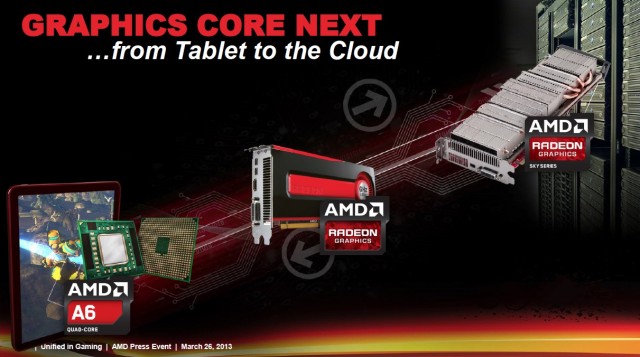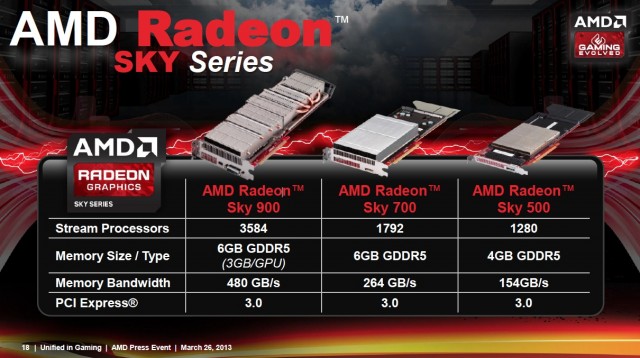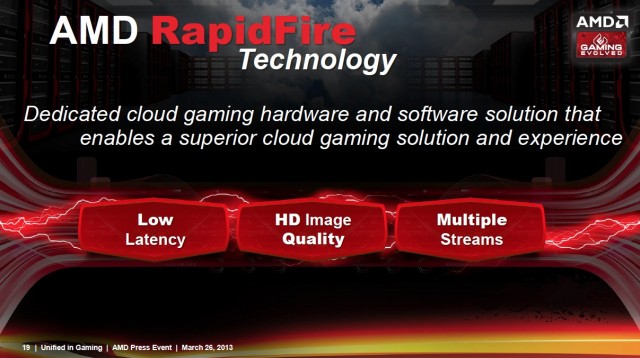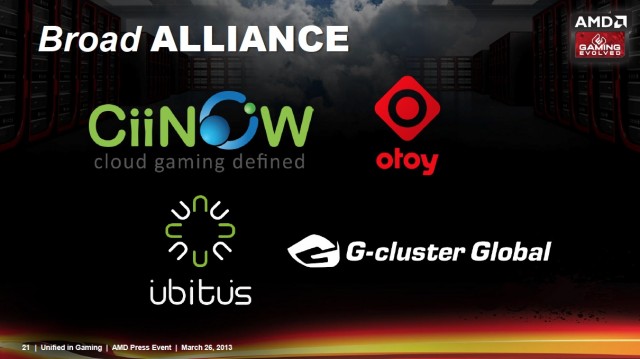
AMD already makes GPUs for tablet, desktops, laptops, and workstations. Next stop: the cloud.
AMD has had a few noteworthy successes in gaming lately. Sony's PlayStation 4 will be using both CPUs and GPUs from the company, and Microsoft's next-generation Xbox is widely expected to do the same. And now, the company has made several announcements at this year's Game Developers Conference that look to maintain that momentum.
AMD announced a couple of new desktop graphics cards, but far more interesting is their entry into a market that Nvidia has been pushing for a little over a year now: cloud gaming. AMD has announced three new "Radeon Sky" server graphics cards that are in many ways similar to the Nvidia Grid cardsthat its competitor announced late last year. Here's all we know about them, based on both AMD's GDC press conference and the Radeon Sky product pages.
The cards

The Radeon Sky lineup. It's worth noting that all three cards are passively cooled.
There are three cards that will be available to start with: the Radeon Sky 900 is a dual-slot card with two GPUs running at 825MHz and 6GB of GDDR5 RAM on a 384-bit interface (each GPU can access 3GB of this RAM). This card includes 3584 of AMD's stream processors across its two GPUs, and consumes 300W of power under load.
The Radeon Sky 700 also includes 6GB of GDDR5 RAM on a 384-bit bus, but has only one 900MHz GPU with 1792 stream processors—it's the same GPU as in the Sky 900, but there's only one of them. This dual-slot card consumes 225W of power under load.
Finally, the Radeon Sky 500 is the weakest card of the bunch. It has a single 950MHz GPU with 1280 stream processors and 4GB of GDDR5 RAM on a 256-bit bus. The benefit is that the card is both physically smaller (it's a single-slot card rather than a dual-slot) and consumes less power (150W).
Like Nvidia, AMD is using the same basic "Graphics Core Next" architecture across most of its product line at this point—the GPU's 900 and 700-series Sky cards have the same number of stream processors as a Radeon HD 7950 desktop card, while the Sky 500 uses the same number as the Radeon HD 7870 GHz Edition card. As a result, the Sky cards work with the same API and feature support as these Radeon cards—Direct3D 11.1, OpenGL 4.2, and OpenCL 1.2 support is available on all of these cards.
The software: AMD RapidFire

We don't know many details, but AMD's RapidFire promises to address at least some of the most common problems with cloud gaming.
As with the Nvidia Grid cards, there are two important problems the Sky cards will need to compensate for: they'll need to be able to reduce latency however possible, and (to be cost-effective) they'll need to support multiple users. AMD is dealing with both problems through something it's calling RapidFire, which the company calls the Sky cards' "secret sauce." We don't have all the details we'd like, but AMD's slide deck from GDC and the Sky product page provides enough to get started.
First, latency: as with Grid, the Sky cards reduce latency in part by encoding the video stream that is being sent to your gaming device directly on the GPU, rather than sending it to another server box dedicated to the task of video encoding. The same Video Encoding Engine (VCE) that speeds up encoding and transcoding in laptops and desktops with AMD GPUs will be used here to reduce the number of steps between the Sky cards rendering a scene and you seeing that scene on your device.
RapidFire also enables the Sky cards to stream "up to" six games at once. The only example AMD provides is for the Sky 700 card, which in AMD's testing could stream three games at once at 60 frames per second or six games at once at 30 frames per second. What we don't know is how the other two cards perform—if they support more or fewer streams, or simply allow the graphics quality on those six streams to be turned up and down. We've reached out to AMD for comment on this, and will update when we get a response.
Finally, AMD is working with companies like VMWare and Citrix to allow virtual machines based on those companies' technology to access these GPUs directly, which according to the AMD will provide "greater density and more simultaneous game streams from a single server." While AMD's focus for these cards is set squarely on cloud gaming, direct access from virtual machines also opens the door to workstation applications—drafting, video, and photo editing software that can make extensive use of the GPU should be able to benefit from direct access to the card just as games can.
Not first, but still competitive

AMD's list of partners so far consists mostly of small or foreign companies, but Nvidia has that problem too.
In most respects, AMD is following Nvidia here. The Radeon Sky cards are aiming for the same general market as Nvidia's Grid (née VGX) cards, and they accomplish most of the same tasks in the same (or, at least, similar) ways. Still, this market is young, and AMD's cards appear to be competitive.
Where AMD's high-end cards appear to beat Nvidia's, at least at the moment, is in number of simultaneous users supported. Even if the Sky 900 card can only support six simultaneous users (something we aren't yet sure of), it still beats the high-end Grid card, which can only support one user on each of its two GPUs (though Nvidia has assured us several times that multiple user support will be added later via a software update). Cloud gaming servers really need to be as dense as possible to help them scale, so the more users that can get a good experience from a single GPU the better.
One area where Nvidia is definitely ahead of AMD here is in hardware: AMD will be reliant on hardware partners to put its cards in servers and then sell them to companies like CiiNow, Otoy, Ubitus, and G-cluster Global (the four companies AMD said would be adopting its technology), while Nvidia is offering neatly packaged hardware directly to consumers in the form of both the Nvidia Grid server (for gaming) and the Grid VCA server (for workstation applications). AMD could well jump into this end of the market itself, if it proves lucrative—it already sells servers through its SeaMicro arm—but as of now it's only selling the cards themselves.
We're still a bit skeptical about cloud gaming, but with both of the major graphics hardware makers in the game, it's going to be easier than ever to buy the hardware you need and get a service up and running. Whether those services succeed is something else again, but Nvidia's Grid and AMD's Sky cards remove one more barrier to entry.
No comments:
Post a Comment
Let us know your Thoughts and ideas!
Your comment will be deleted if you
Spam , Adv. Or use of bad language!
Try not to! And thank for visiting and for the comment
Keep visiting and spread and share our post !!
Sharing is a kind way of caring!! Thanks again!